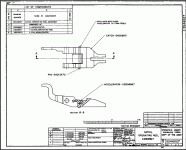I thought, from the first post, the gun had run just fine until you disassembled and reassembled it. If so, the gas system won't suddenly go out of spec like that. It'll have a gradually increasing number of failures as it wears. Also, if you follow the reloading forum on the CMP website, you'll find folks getting good operation from loads much lighter than M2 Ball, while still others use vented gas plugs (similar effect to the loosening of the gas system) to bring down pressure for less vigorous operation, and still others have had new piston heads silver brazed onto their operating rods after having the old one cut off, shortening the rod and thereby increasing the volume the gas port is feeding, and the gun still runs. So, I am still suspicious something in your assembly is off.
Ammo:
The bulk IMR 4895 used by FA and Lake City for National Match ammo from the years 1957-1966 varied about 5% in burn rate based on the variation in charge weights they used during that period and the actual velocities they got over those years. If we take the load ranges Hodgdon posts for the 150-grain Nosler BT and the 175-grain SMK and use those bullets as surrogates for the 152 and 174.5-grain M2 and M1 Type (for M72) bullets, and we assume Hodgdon's loads are for the center values of current production IMR4895 burn rate, to produce M2 and M72 muzzle velocities would take charges of 47.6 and 47.5 grains of IMR4895, respectively, using those bullets as loaded by Hodgdon. They are remarkably close charge numbers, and, as you might guess, the heavier bullet load, with its slower exit speed, will provide the greater gas impulse to the gas cylinder, so you will get a harder shove on the gas system with the 175-grain load than with the 150-grain load.
One issue with these substitutions is the seating depth and bullet length differences are enough that the original M2 Ball bullet could have required another grain or so of powder. But that's a factor you can adjust for, as I will describe further down.
Note that 47.6 grains is below Hodgdon's starting load for the 150-grain bullet, but 47.5 grains is in the middle of their range for a 175-grain bullet, so the latter load should be backed down to 46 grains (Hodgdon's starting load) and worked up to that value.
A note on the muzzle velocities. The military traditionally measured these at 78 feet from the muzzle. In 1962, LC switched to 15 feet for M72 NM. I don't know whether the M2 standard was ever changed or not, but in 1962 LC was becoming more concerned with National Match ammunition accuracy performance and changed their test protocols some. I have worked backward from those numbers to get the following averages:
For M2 to run 2740 fps at 78 feet from the muzzle of a velocity and pressure (V&P) test barrel chambered with the powder back over the flash hole, as the military qualifies it, the equivalent velocity at 15 feet (where Hodgdon measures it per SAAMI procedure) would be 2790 fps. So, that's the number to use when adjusting Hodgdon's data for M2 velocity. (If you want to get really picky, take off one foot per second to 2789 fps to allow for the military numbers being for U.S. Army Standard Metro conditions and Hodgdon's being adjusted to an ICAO standard atmosphere.)
For M72, the 15-foot velocity would be 2680 fps.
Note that the Hodgdon data uses a Winchester case and Winchester primer. You might want to acquire a few of those particular items and some of the Nosler bullets and use the SMKs you have already and load them exactly as Hodgdon specifies, the same COL in particular. Set up with a chronograph and fire over it, handling the cartridges so the powder lays back against the flash hole. This will tell you what your gun's velocities are with that load, as compared to the Hodgdon V&P barrel, which will have much tighter chamber specs. You can then adjust your numbers proportionally. That is, if your gun gets 50 fps less than the Hodgdon V&P barrel did when you switch bullets and primers and COL around, that's the target velocity you want to hit with them fired the same way.
Pay attention to keeping the powder back. Testing with National Match ammo years ago, I found the difference between the powder being back over the flash hole (tipped the loaded rifle's muzzle up before slowly bringing it down level to fire) and having it forward in the case (tipped muzzle down before slowly bringing it up level to fire) was about 80 fps. It was also the difference between a noticeably flattened (though not excessively) and a rounded primer, I knew the pressure difference was following it at almost 7000 psi difference.
Also, note that the test gun does not have to be your Garand. The Hodgdon gun was not, and the military V&P barrel was not. A bolt rifle with positive feed makes it a little easier to keep powder oriented the way you want as you close the chamber. Just use the same ratio of your gun's velocity to the V&P barrel gun's velocity to get translated to your components and develop that load in the same gun.




